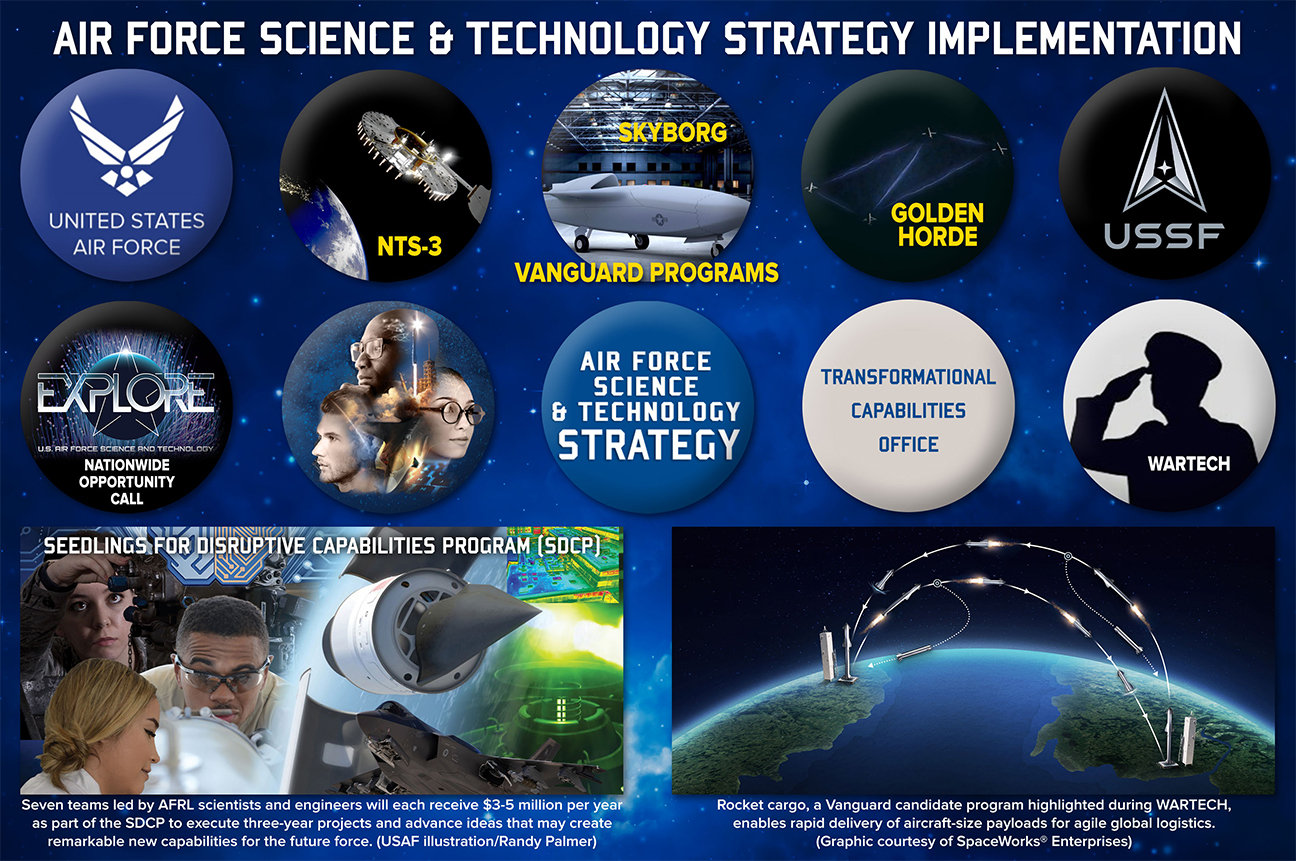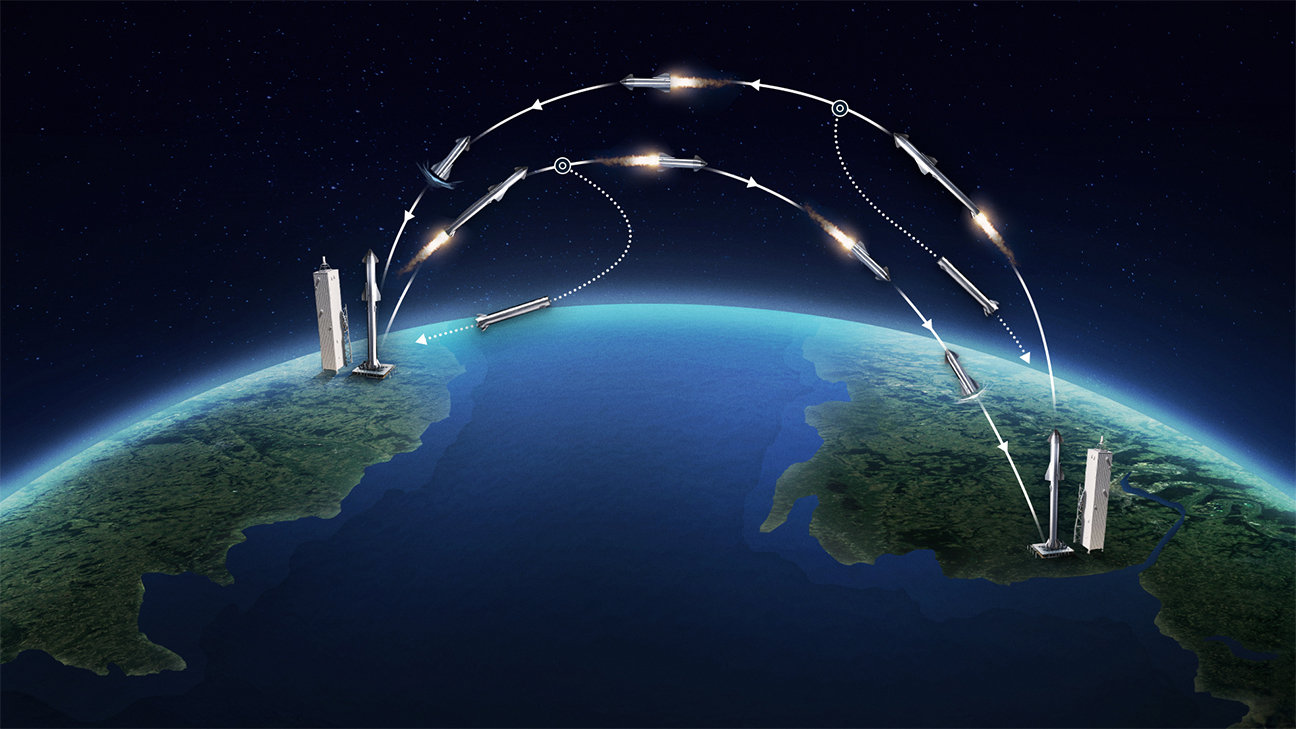U.S. Army General Stephen R. Lyons, commander of U.S. Transportation Command (TRANSCOM), recently stated that new space technologies being developed by industry partners could soon be able to deliver large loads of cargo to anywhere on the planet in just one hour.
Lyons made the comments while speaking at the National Defense Transportation Association’s virtual Fall Meeting on October 7. TRANSCOM has forged a partnership with both SpaceX and Exploration Architecture Corporation (XArc) to pursue rapid delivery concepts. XArc is a consulting firm offering expertise in space station and spaceport design, planetary surface systems, and other technology development programs aimed at space exploration and commercialization.
TRANSCOM provides transportation services and solutions to every branch of the armed forces, as well as various other defense and governmental organizations. By providing a vast logistical network that spans every transportation domain, TRANSCOM boasts that it offers “the most responsive strategic mobility capability the world has ever seen.”

Lyons told attendees at the National Defense Transportation Association’s virtual meeting that the new rapid delivery architecture SpaceX and XArc are working on could be in place as soon as next year:
“Think about moving the equivalent of a C-17 payload anywhere on the globe in less than an hour. Think about that speed associated with the movement of transportation of cargo and people. There is a lot of potential here and I’m really excited about the team that’s working with SpaceX on an opportunity, even perhaps, as early as [20]21, to be conducting a proof of principle. I had no sense for how fast SpaceX was moving, but I’ve received their update and I can tell you they are moving very rapidly in this area.”

According to a USAF fact sheet, the C-17 Globemaster has a top speed of around 520 mph and a maximum payload of around 82 tons, although normal payloads are around roughly 60 tons or less. In comparison, a rocket that can deliver cargo to anywhere in the world in 60 minutes would require an average speed of around 9,000 miles per hour.
A TRANSCOM press release says that the unprecedented types of point-to-point space launches Lyons is describing will require the DoD to examine every “legal, diplomatic, statutory, and regulatory issues that must be addressed to enable the normalization of high-frequency, point-to-point, commercial space launches.” To that end, the command has signed Cooperative Research and Development Agreements (CRADA) with its industry partners in order to facilitate this radical new form of transportation.

Many of the details of TRANSCOM’s vision for these space-launch cargo deliveries are still unknown and it’s likely those details are what the CRADAs will explore. For example, it’s unknown if these launches will consist of an entire stack landing vertically or a cargo capsule being dropped from suborbital space.
The TRANSCOM press release announcing this CRADA also does not mention how much each of these launches will cost, but an average SpaceX Falcon 9 launch costs anywhere from $50 million to $62 million. That’s still less than the cost of an average NASA launch, but drastically more than a C-17 flight. The C-17’s cost per flight hours varies depending on how it is calculated, but taking a $30,000 per hour figure, 18 hours of flight time to get halfway around the world would cost roughly $540,000, which is around 1/100th the cost of a SpaceX launch.
With this in mind, some budgetary experts have already cast doubts on TRANSCOM’s plans, noting that it will likely be decades before the concept of space-based cargo deliveries could be cost-effective.

Other experts have questioned the concept altogether, noting that point-to-point space launches will usher in a new host of issues that must be addressed before this concept gets off the ground. Victoria Samson at the Secure World Foundation told Breaking Defense‘s Theresa Hitchens that TRANSCOM’s plans open up a regulatory can of worms:
It seems like it would provide a host of traffic management questions, as well as spaceport issues. Where would these craft be taking off/landing? Will we have spaceport bases in allied territory, and if not, how does this benefit our troops overseas if we still have to move them through ground transportation systems?
It isn’t exactly clear what kind of scenarios would require this type of high-cost rapid transport, either. One could imagine using the system for moving very time-sensitive equipment and supplies to forward operating locations, but even if the cost is far less than an actual SpaceX orbital launch, it would still likely be a huge investment every time it is used. The exact infrastructure requirements are also unknown as is just how such heavy loads will be delivered safely. Suborbital flights would drastically increase the available payload of a system like Falcon 9, as opposed to its orbital insertion mission, but safely landing tens of tons of cargo in some sort of a cost-effective manner remains a question mark, albeit one that will be really interesting to see solved.
This certainly isn’t the first time the U.S. military has fancied the ability to move things around the globe, including people, far faster than existing airlift concepts can provide. In 2018, now-retired Air Force General Carlton Everhart, then-head of that service’s Air Mobility Command (AMC), which is part of TRANSCOM, made similar comments about space-based logistics after having sat down with SpaceX, as well as Virgin Orbit.
“Think about this. Thirty minutes, 150 metric tons, [and] less than the cost of a C-5 [cargo plane],” Everhart said. “I said, I need to get me some of that. How do I do that?”
Those remarks prompted many of the same questions that still exist now. Those same issues have dogged similar efforts that have come and gone since the 1960s, including the abortive Small Unit Space Transport and Insertion (SUSTAIN) effort, which received support from the Pentagon’s National Security Space Office and U.S. Marine Corps in the 2000s and was said to be “doable” by the end of the 2010s. You can read more about that project and other efforts in the context of Everhart’s 2018 comments in this past War Zone piece.

Still, SpaceX is no stranger to giving the DoD what it wants. It has previously teamed up with the U.S. Air Force to offer datalink services through their Starlink satellite constellations for the USAF’s burgeoning Advanced Battle Management System (ABMS). ABMS is designed to link U.S. forces and allies across all domains, enabling real-time data fusion and sharing on an unprecedented level. Dr. Will Roper, Assistant Secretary of the Air Force for Acquisition, Technology, and Logistics, has previously stated that data is now an essential warfighting resource as valuable as jet fuel, and is “the key to next-gen warfare.” SpaceX was recently awarded around 40% of the U.S. Space Force’s launch service contracts through 2024 and another $149 million to develop early warning satellites for the Space Development Agency (SDA).
While Lyons’s comments about the potential for planet-wide deliveries in one hour may sound like an exaggeration, it does follows along with other recent comments made by other military brass. Just last year, retired Air Force Lieutenant General Steven Kwast claimed that existing cutting-edge technology makes it possible to “deliver any human being from any place on planet Earth to any other place in less than an hour.”
While TRANSCOM hasn’t mentioned delivering personnel using rockets, SpaceX founder Elon Musk has stated that the company’s Starship rocket will soon enable point-to-point travel – for those willing to withstand the Gs such a trip would exert on the body. Kwast’s comments remain peculiar, but using rockets for rapid transport across the globe could point in the direction of his claims. Still, we are not talking about a man rating for the system at this time, at least according to TRANSCOM.

This development is only the most recent in a strengthening partnership between the DoD and industry partners like SpaceX and other commercial spaceflight firms. As space continues to play an increasingly vital role for the militaries of the 21st century, and as it becomes increasingly contested, it’s likely we will begin to see more radical developments like this one that has the potential, at least in theory, to change military logistics and other aspects of warfare forever.
UPDATE:
Our friend @lfx160219 over on Twitter sent us these two Air Force slides about this initiative. We cannot attest to how accurate they are as of now, but it looks like a Starship derivative being used in a suborbital to vertical landing mode. Hard to imagine this working in areas without some infrastructure to support it. So, one would imagine a hub and spoke model for delivering the goods ‘the last tactical mile’ via traditional airlift. This method would still get the materiel into a theater very quickly though.


Contact the author: Brett@thedrive.com
